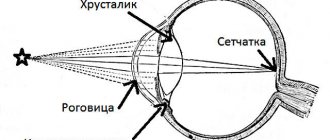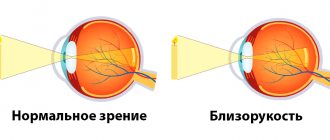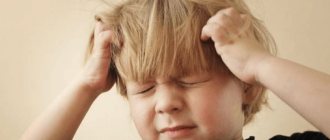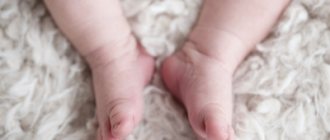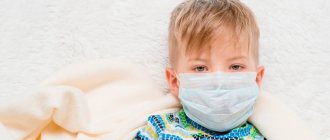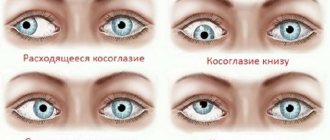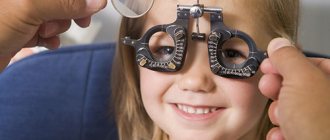08/15/2018 A child at any age (including a one-year-old) can develop myopia. In older children (6, 8 and 10 years old), it usually appears due to high strain on the eyes due to school or prolonged use of the computer.
Recently, the disease has been rapidly growing younger, and therefore, in order to prevent its development in your child, you should take preventive measures in advance.
Congenital myopia is a rare phenomenon; in most cases, children are farsighted. For one possible reason, this disease is caused by abnormalities in intrauterine development.
Myopia in children can develop for the following reasons:
- Heredity - as a rule, if parents suffer from myopia, then children are at risk. The development of the disease is caused by insufficient development of the eye tissue, which stretches as the eye grows.
- Congenital abnormalities - pathologies of the lens or cornea are possible; congenital glaucoma can cause the development of myopia.
- High strain on the eyes - looking at moving objects for a long time causes severe eye strain in children, which can result in the development of myopia.
- Poor health – myopia can develop as a result of previous illnesses not related to vision. Therefore, it is important not to neglect existing diseases.
- Poor diet – lack of vitamins can be one of the main reasons for the development of myopia in children.
- An inconvenient workplace - poor lighting on a child’s desk, incorrectly selected furniture - can lead not only to poor posture, but also to the development of myopia.
Myopia: what is it?
Myopia or, as it is popularly called, myopia, is a disease of the visual system, manifested by an excessive increase in the anteroposterior axis of the eyeball. As a result, the focus of the image is formed in front of the retina, and not directly on it. The consequence is deterioration of distance vision. A patient with myopia sees objects that are nearby normally. However, as the distance between it and the object increases, the picture begins to lose clarity and blur. In addition, myopia is not just a deterioration in vision. Each additional diopter of myopia increases the risk of future serious complications such as myopic maculopathy, retinal detachment, cataracts and glaucoma. Therefore, it is very important to diagnose myopia as early as possible and begin appropriate therapy.
Drug treatment
To improve and maintain vision with myopia, the ophthalmologist may recommend drug treatment to the child using such means as:
- drops: “Irifrin”, “Emoxipin”, “Ujala”, etc.;
- group of drugs (drops) with atropine (0.01%);
- vitamin complexes.
If a child has been diagnosed with myopia, a comprehensive approach to treatment should be used. That is, the use of drugs is prescribed in parallel with wearing optics and performing hardware procedures.
When does myopia appear?
Such a refractive error may be:
- congenital pathology, manifests itself in preschool age;
- An acquired disorder that appears mainly in early school age, such myopia is sometimes called “school myopia.”
Numerous studies have shown that myopia develops most actively during the educational period, from 9 to 12 years. However, there is also a risk of developing the disease in older adolescence - 15-16 years.
Classifications of myopia by severity
In ophthalmology, there are three degrees of myopia:
- Weak - a violation of up to -3 diopters. The child does not feel any discomfort - he does not have headaches, dizziness or distraction. The only sign of myopia at this stage is that when the child moves 5-10 meters away from an object, he sees it blurry. Typically, the first symptoms of the disease appear at the age of 6-8 years.
- Medium - the degree of impairment ranges from -3 to -6 diopters. At this level, children may have difficulty identifying objects that are further than their arm's length. Often children with moderate severity of the disease complain of eye pain and fatigue. As a rule, the disease reaches this stage by the age of 11-13 years.
- High - over -6 diopters. High refraction values are characteristic of congenital myopia. With a high degree of myopia, the child is not able to navigate in space without the use of vision correction. He is unable to see objects further than 10 centimeters from his face. Myopia reaches a high degree on average by the age of 14, when the load on the eyes becomes maximum.
Optics for children
Wearing glasses for myopia helps relieve eye strain and creates conditions for the proper development of the child’s visual organ. Depending on visual acuity, glasses can be prescribed only for distance (usually for low myopia) or for constant wear (for moderate and high myopia). According to indications, it is possible to prescribe soft contact lenses for children starting from school age, for example, if there is myopia in only one eye or with different degrees of myopia in the eyes and poor tolerance of glasses, when the child plays certain sports, if the child refuses to wear glasses, etc. In order to inhibit the progression of myopia, orthokeratological lenses (“night lenses”) are prescribed. In any case, the correct selection of correction means is carried out by an ophthalmologist after examining the child.
Reasons for the development of myopia in children
Myopia or myopia can occur in children for several reasons:
- Genetic predisposition . If both parents suffer from myopia, there is a 50% chance that the child will also develop the disease1. If only one of the parents has myopia, the probability of developing myopia in the child is 30%. But even in the case when both parents have good vision, there is still a chance of myopia in the child and it is equal to 25 percent.
- Congenital myopia . Most often, premature babies suffer from congenital myopia. This is due to the general weakness and vulnerability of a fragile body and increased extensibility of the sclera. As a rule, in this case, myopia appears during the first year of the baby’s life.
- Acquired myopia . Usually detected at the age of 9-12 years.
Congenital myopia
Read our article about congenital myopia.
Symptoms, prevention, causes and diagnosis Read…
Acquired myopia occurs due to:
- excessively rapid and intense growth of the child. A sharp jump in growth of the entire body, including the eyeball, leads to the development of myopia;
- increased load on the eyes, leading to overstrain of the visual system. It is this reason that in most cases leads to the development of myopia in schoolchildren;
- multiple increases in eye strain during the educational process;
- improper organization of the child’s workplace;
- lack of lighting in the room;
- spending a long time at the computer or with any gadget;
- lack of optimal distance between the eyes and the notebook/textbook;
- weakening of the body due to illness/unhealthy lifestyle/poor nutrition.
Considering that myopia can develop at any age, it is important to promptly examine the child from the first days of life. There is no need to wait until he is 7-9 years old. Preventing a disease is always easier than treating it. Timely prevention and vision correction can preserve the health of the visual system.
Conservative methods of treating myopia
The first stage in the fight against myopia is optimal vision correction with glasses. While wearing them, the ophthalmologist determines the magnitude and rate of development of the myopic process.
When selecting glasses, the shape and size of the face must be taken into account. The frame should not interfere with the visual field, and the glass should provide stable binocular vision and its acuity in the range of 0.9-1.0. It is better for children not to wear glasses all the time; they are only needed on the street and at school, when looking at distant objects. When working without eye strain: reading, writing, drawing, working at close range, it is not necessary to use glasses. In cases of medium or high degrees of myopia, it is better to use bifocal glasses, whose glasses have two optical powers, with the lower one being weaker than the upper by about 2.0-3.0 D. In the case of high degrees of myopia in combination with anisometropia (more than 3.0 D ) it is better to carry out correction with contact lenses.
Good results in the prevention of myopia are provided by physical education and certain sports (swimming, skiing, race walking, running, skating), as well as active games in the fresh air.
A positive aspect for stabilizing the myopic process is taking phosphorus and calcium supplements and enriching the diet with vitamins. Treatment of chronic diseases and sanitation of the oral cavity, prevention of obesity, plus active treatment of endocrine system disorders, especially in adolescence, are mandatory.
According to age, it is necessary to establish an optimal alternation of work and rest, to introduce a special regime of visual work. Excessive physical activity (sudden movements, sports, jumping, etc.) should be eliminated.
The concept of a special regime for visual work includes the correct wearing of glasses, provision of the necessary lighting above the work area, and mandatory breaks when performing visual work. Thus, for children with weak and moderate degrees of progressive myopia, breaks from work should be taken every 15 minutes, and with high myopia, vision can be strained for no more than 10 minutes. At the same time, the rest time from visual work should be at least 5-10 minutes.
Treatment of severe, rapidly progressive myopia is a serious task and, in most cases, quite difficult. If changes are detected in the macular region of the retina and recurrent hemorrhages occur, it is imperative to minimize visual strain, protect the eyes from bright light, and provide them with rest. Local and general medicinal treatment using drugs is also indicated: calcium chloride, cysteine, solutions of ginseng and Chinese schisandra, ethylmorphine hydrochloride, metazone. Sometimes subconjunctival oxygen injections and reflexology are prescribed. Very useful vitamins for patients with myopia are: rutin, ascorbic acid, vitamin E, thiamine, riboflavin, interludes, adenosine triphosphoric acid, etc.
Weakening of accommodation can be eliminated by performing special exercises to train the ciliary muscle. Such exercises are especially effective in cases of low degrees of myopia and can even normalize vision. Training complexes often include classes with diverging and collecting lenses, which provides the so-called. physiological massage of the ciliary muscle.
The impact of myopia on a child's daily life
The consequences of myopia in children are:
- difficulty in perceiving text written on a blackboard,
- difficulties when playing with the ball,
- rapid eye fatigue while reading, writing and working at the computer.
In most cases, schoolchildren suffering from myopia experience poor performance. Often, illness affects a child’s self-esteem—children are forced to limit their range of interests and hobbies, which leads to the student becoming withdrawn and lacking self-confidence. At the first signs of myopia, you should immediately show the child to a specialist and begin timely treatment of the pathology.
Preventing poor visual habits
But in addition to everything, parents should engage in the prevention of incorrect visual habits in their children. Teach them to sit correctly at their desk. Make sure that while working, the light falls on the book or notebook evenly, while at the same time your head and face should remain in the shadow. It is best to practice with a table lamp, leaving general lighting. This is especially important at night. It is necessary to avoid tilting the child’s head close to the subject of work; the best distance for visual activity is 30–35 cm. It is advisable to exclude various glare or reflective surfaces from the child’s field of vision while working. The bad habit of reading while lying down can be another factor that provokes myopia. It is necessary to take breaks after every 30-35 minutes of working at a desk (for younger students - 20-25 minutes), during which you can have a snack, do eye exercises, warm-up exercises, or just relax.
Symptoms: how to recognize myopia?
Myopia can appear at any age. Obviously, it is easier to correct the negative consequences of the disease at first. Therefore, adults need to carefully monitor the child’s behavior and be able to promptly recognize the first symptoms of pathology. Children may not realize they have vision problems because they do not understand what is normal. It is recommended to have a preventive examination with an ophthalmologist at least once a year. If the following symptoms occur, you should consult a doctor immediately:
- When looking at distant objects, the child squints.
- The child is often bothered by headaches, which in most cases occur after work associated with visual strain - reading, doing homework, working on the computer, watching TV or playing a tablet.
- While reading, the child brings the book too close to his face, bends low towards the notebook, and comes closer to the TV to look at the picture.
- The child complains of pain and burning in the eyes, blinks frequently and constantly rubs his eyes.
- Absent-mindedness and constant change of activity. The child constantly switches his attention and cannot do one thing for a long time (most often this symptom manifests itself in schoolchildren over 8 years old).
Even if a student has only one of the above symptoms, this is a reason to seek help from a specialist. Otherwise, the disease may progress and correcting the situation will be much more difficult.
Clinical manifestations of childhood myopia
Congenital myopia in a young child can only be determined by an ophthalmologist during an examination. The disease in an older child can be suspected if the following manifestations are present:
- frequent squinting of the eyes;
- the appearance of the habit of wrinkling the forehead;
- frequent blinking;
- complaints of discomfort and pain in the eyes;
- headache;
- complaints that the eyes get tired quickly;
- the habit of bowing your head low when drawing.
The presence of the above requires immediate contact with an ophthalmologist. If treatment is not started promptly, the following complications are possible:
- strabismus;
- "lazy eye" syndrome;
- pathological changes in the retina;
- hemorrhages and retinal detachment;
- vitreous detachment.
Often, during an examination, the ophthalmologist diagnoses false myopia, which is characterized by difficulty maintaining a clear image of objects. If the necessary correction is carried out in a timely manner, the risk of this form transforming into true myopia can be eliminated.
Diagnosis of the disease
Diagnosis of visual impairments is possible both in public medical institutions and in private medical centers and opticians. The advantages of private institutions are the availability of more modern diagnostic equipment and the time that a specialist can spend working with one patient.
At the first stages of the examination, the doctor collects information from the child and parents. This allows you to find out what exactly worries the patient, how long ago the symptoms of the pathology arose. The ophthalmologist may need information about the course of pregnancy, how the birth went, and what diseases the parents and child have encountered in the past.
Modern methods for diagnosing the visual system are selected based on the patient’s age. Children under five years of age are examined only using specialized instruments. Older children are tested on a table with images of various letters, symbols and drawings.
In addition, diagnostics may include such procedures:
- Fundus examination.
- Ultrasound of the eyes . It is performed to assess the length of the anterior-posterior axis of the eye and detect pathologies, if any.
- Refractometry . At this stage, the doctor evaluates the refraction of the eyes (their ability to see at various distances).
- Skiascopy . The ophthalmologist uses a special skiascopic ruler for diagnosis and thereby determines the type and degree of the anomaly.
- Biomicroscopy , that is, examination using a microscope. Allows you to assess the condition of the anterior segment of the eye, thereby eliminating possible contraindications for various methods of further management of the child.
- Upon completion of the diagnosis, the ophthalmologist will diagnose the child, determine the severity of the disease and select the appropriate treatment.
Night correction of childhood myopia
Modern methods of treating myopia include, among other things, nighttime correction. Already from the age of 6, young patients can be prescribed special orthokeratological hard lenses, which are worn before bed for 6-8 hours. During this period of exposure to the eye, a partial change in the shape of the cornea occurs due to the rigid fixation of the optics. As a result, the refractive power indicators change and throughout the daylight hours the child sees the world around him much better. At the same time, optical products help relieve spasm of accommodation. The effect of night lenses can last up to 48 hours. Then re-application is required.
Preventive diagnostics
Parents should make it a rule to regularly visit a pediatric ophthalmologist. Infants need to be seen by a specialist between the ages of one and twelve months. After this, it is mandatory to undergo an vision test at 3 years of age (provided that no symptoms of myopia were identified between 1 and 3 years of age).
Schoolchildren should undergo visual examinations at least once a year. At the age of 8-12 years this is especially important. Because it is during this period of time that the school curriculum increases the load on children’s vision.
Note to parents
The number of myopic children in different countries of the world, and often within the same country, varies significantly. In different regions of Russia, myopia is detected in from 2.3% to 13.8% of schoolchildren, and among high school graduates - from 3.5% to 32.2%. The peak age period for the development of myopia is considered to be 10–12 years, although recently the number of myopic children among primary school students has been rapidly increasing.
Experts have found an increase in the number of myopia in northern latitudes compared to southern latitudes and a lower prevalence of myopia among children in rural areas compared to urban ones. An explanation for these factors can be found in the peculiarities of the light regime, nutritional conditions, the time children spend in the fresh air, the degree of visual load, sports activities, etc.
Myopia treatment, vision restoration, correction
Treatment of myopia refers to the management of patients using techniques aimed at correcting vision and slowing the progression of myopia. To correct vision, glasses and contact lenses of various optical designs are prescribed.
Methods to slow the progression of myopia include:
- bifocal/multifocal glasses;
- orthokeratology;
- bifocal/multifocal contact lenses;
- daily contact lenses with dual focus;
- atropine eye drops.
Some of the listed techniques can simultaneously achieve vision correction and slow down the progression of myopia. In each specific case, the doctor chooses a method or combination of methods for managing the patient in accordance with his data and individual characteristics. In addition, parents receive a number of recommendations for adjusting the child’s diet and lifestyle, which will contribute to greater effectiveness.
Optics for myopia correction
Glasses and contact lenses can correct myopia and are suitable for children of any age. Regardless of the degree of myopia, the most important condition is the child’s constant use of the prescribed correction. Such options are not allowed when the child wears glasses for half the day, and in the evening takes them off and stays at home without correction. Or, for example, using glasses or contact lenses only on weekdays, and no correction on weekends so that “the eyes can rest.”
On the contrary, for the physiological functioning of the eye muscles, the correction should be used all the time the child is awake. That is why the doctor, together with the parents, find out the features of the child’s daily routine, his hobbies, sports, relationships with peers, etc. And only then is a decision made in favor of glasses or contact lenses.
A significant problem is the child's reluctance to wear glasses. As a rule, this reluctance is associated with fear of ridicule from peers or the inability to engage in active sports and dancing. If the above-mentioned facts are revealed during communication, then there is no need to “pressure” the child and force him to use glasses. In this case, contact lenses become a reasonable recommendation. Unfortunately, there is a common misconception in society - contact lenses are not suitable for children. Of course this is not true.
Firstly, children can wear the same lenses as adults, since the size of a schoolchild’s eyes does not differ from the size of an adult’s eyes. Secondly, a number of studies have demonstrated a high level of safety in the use of contact lenses by children. The risk of complications was lower than in adults. This is due to the fact that children are under the control of their parents and do not violate the wearing regime and rules for caring for lenses. And finally, contact lenses allow the child to feel more confident and free.
There is no risk of breaking or losing lenses, it becomes possible to play sports and outdoor games and at the same time see well, go to school and not be embarrassed by poor vision. In this case, the doctor and parents can be sure that the child will be corrected throughout the day.
Now in a number of countries, including Russia, soft contact lenses for daily replacement have appeared, which allow not only to achieve good quality vision, but can also slow down the progression of myopia. The effect of these lenses is due to the presence of a complex optical system that produces results regardless of the lighting conditions in which the child is located.
Thus, to all the benefits of contact lenses, you can add slowing down the progression of myopia. The sooner a child diagnosed with myopia begins using these lenses, the more likely it is that he or she will not develop moderate to severe myopia. If your child likes the idea of wearing glasses, remember that not all glasses are equally effective in slowing the progression of myopia. The most effective type of lenses for corrective glasses are special bifocal designs.
What is myopia?
You will find a detailed answer to this question in the article on our website.
Causes, diagnosis, symptoms, treatment of myopia and much other useful information Read more…
Hardware treatment of myopia
Hardware treatment is not an independent type of management of patients with myopia. As a rule, it is prescribed in addition to vision correction and techniques to slow the progression of myopia. The main goals of hardware treatment are to normalize the tone of the eye muscles and restore the neurological parameters of the visual system.
The most popular methods are:
- Electrical stimulation . Due to the currents of the device, individual areas of the eye are stimulated. This allows you to restore conductivity and restore functionality to the optic nerve.
- Laser exposure . The device activates receptors located on the retina of the eye.
- Vacuum massage . Increases blood circulation and relaxes the organs of the visual system.
Drug treatment of childhood myopia
Today, atropine in low concentrations is considered one of the effective methods for slowing the progression of myopia. However, it was not widely used. This is primarily due to the limited availability of this drug, and there are also concerns that after discontinuation of atropine, the so-called “rebound effect” is possible, that is, the rapid progression of myopia during the first year after stopping its use. The remaining drugs are more of an auxiliary nature and only complement the set of measures to correct vision and stop the progression of myopia.
Drugs that improve the functioning of the visual system are:
- specialized vitamin complexes for the eyes;
- preparations with nicotinic acid;
- drugs that promote general strengthening of the vascular system.
The doctor selects the appropriate medications. He also determines the order of administration of funds and the dosage for each drug.
Surgical solution to the problem
Laser correction can improve the vision of patients with myopia. However, it is important to understand that this is not a treatment for myopia. If the length of the eye has already increased excessively, then it cannot be changed back. Consequently, the risk of complications associated with myopia remains. In addition, doctors recommend this method after the progression of myopia has stopped. This usually happens after 18 years of age.
An exception to the rule may be scleroplasty - strengthening the sclera of the eye. Doctors resort to this operation in cases where myopia is actively progressing and threatens irreversible vision loss.
One of the most common diseases in children is myopia, or myopia. Most often it manifests itself during the school age of the child, which is usually associated with increased eye strain.
In the first year of life, myopia appears in 4-6% of children. Due to the growth of the eyeball, myopia is less common in preschoolers, but in children 11-13 years old, myopia is observed in 14% of cases.
Causes of myopia
Myopia can be congenital or acquired.
The immediate cause of the development of myopia is a violation of the proportion between the power of refraction (refraction) and the length of the anterior-posterior axis of the eye.
Due to a violation of the relationship between the size of the eye and refraction, the image of objects does not fall on the retina (as it should), but in front of it. Therefore this image will be blurry. And only negative lenses or bringing an object closer to the eye can produce an image on the retina, that is, a clear one.
Risk factors for the development of myopia are:
- heredity;
- fetal prematurity;
- congenital anomaly of the eyeball, lens or cornea;
- congenital glaucoma (increased intraocular pressure);
- increased visual stress;
- violations of visual hygiene;
- infectious diseases (including frequent acute respiratory viral infections, influenza, pneumonia);
- poor nutrition of the child;
- decreased immunity;
- some common diseases (diabetes mellitus, Down's disease, etc.).
The hereditary factor is of great importance for the development of myopia, but it is not the disease itself that is inherited, but the predisposition to it. Moreover, it increases significantly if both parents have myopia.
Congenital myopia may not progress if there is no hereditary predisposition (weakness or high extensibility of the sclera). But, as a rule, they are combined and lead to severe vision loss and constant progression. These irreversible changes in the eye can even cause disability. Myopia also develops in the case of a combination of glaucoma and scleral weakness.
In rare cases, infants have temporary, transient myopia. 90% of full-term children have “farsightedness with a margin” of 3-3.5 diopters. Farsightedness is therefore normal for children. This is due to the small size of the eye: the anterior-posterior axis of the eye in an infant is 17-18 mm, by 3 years it reaches 23 mm, in adults – 24 mm.
It can be seen that the greatest growth of the eyeball occurs before the age of 3, and its full formation is achieved at 9-10 years. During this period, the “reserve” of farsightedness is consumed, and eventually normal refraction is formed.
But if at birth there is farsightedness of 2.5 diopters (or less) or generally normal refraction, then the likelihood of the child developing myopia is very high: such a “reserve” is not enough for the eyeball to grow with age.
In premature babies, myopia develops in 30-50% of cases.
But still, more often children develop acquired myopia, which progresses during their school years.
This is facilitated by:
- significant strain on the eyes;
- posture disorders;
- improper organization of a workplace for a child;
- poor nutrition (lack of vitamins, magnesium, zinc and calcium);
- excessive passion for the computer and TV shows.
Some parents mistakenly believe that the glasses prescribed for their child contribute to the progression of myopia. This is wrong. Myopia will increase only with incorrectly selected glasses.
It is also a mistake to believe that myopia develops as a result of reading a large number of books. Myopia can be associated with reading only in the case of incorrect body position when reading or insufficient lighting.
Symptoms
A child with myopia has reduced visual acuity and finds it difficult to see distant objects.
The first sign of myopia in a child is a decrease in distance visual acuity, which causes the child to squint. Sometimes such visual impairment is temporary, transient, and reversible.
A symptom of myopia is also the rapid onset of eye fatigue when reading or when looking at any objects close up. Children may try to move their eyes closer to the text while reading or writing.
Myopia detected at this stage can be stopped, which is why it is so important to show the child to an ophthalmologist regularly, regardless of whether he or she has any complaints.
A divergent strabismus in a 6-month-old baby (or older) can also be a manifestation of myopia. In this case, consultation with an ophthalmologist is also necessary.
After a year, evidence of myopia may be the baby's frequent blinking and his desire to bring any object closer to his eyes for examination.
At school age, children may not see the text written on the board, but from the first desk they can see better. Near vision remains normal. Guys also notice rapid eye fatigue.
This condition can cause not only myopia, but also a spasm of accommodation (that is, a spasm of the intraocular muscles that regulate the refractive power of the eye). The spasm can be a manifestation of vegetative-vascular dystonia in a child, increased nervous excitability, or appear when the rules are violated while reading (insufficient lighting, incorrect posture, etc.).
The appearance of “floating spots” before the eyes may indicate a complication of myopia - destructive changes in the vitreous body.
There are the following types of myopia:
- physiological: appears during eye growth;
- pathological: is actually a myopic disease; differs from physiological myopia in its progressive course;
- lenticular: associated with high refractive power of the lens when it is damaged due to diabetes mellitus, congenital cataracts or exposure to certain medications.
According to the course, myopia can be non-progressive and progressive.
According to the severity of myopia, there are:
- weak (up to 3 diopters);
- medium (3-6 diopters);
- strong (above 6 diopters).
Diagnostics
- Survey of the child and parents: allows you to find out the presence of complaints and the timing of their appearance, the course of pregnancy and childbirth, previous and concomitant diseases, family or hereditary factors, changes in visual acuity over time, etc.
- Examination of the child includes:
- External examination of the eyes: makes it possible to determine the position and shape of the eyeballs;
- examination with an ophthalmoscope: determination of the shape and size of the cornea, assessment of the anterior chamber of the eye, lens and vitreous body, examination of the fundus; with myopia, a myopic cone is detected around the optic nerve head, atrophic changes in the fundus, pigmentation and hemorrhages, and even retinal detachment with high myopia may be observed;
- skiascopy (using an ophthalmoscope and a skiascope ruler) to determine the type of refraction and degree of myopia;
- Ultrasound helps determine the size of the anterior-posterior axis of the eye and identify the presence of complications;
Up to 3 years, only the named methods are used, but the results are compared with previous data (at 3 and 6 months).
From the age of 3, visual acuity is additionally checked using special tables. If visual acuity is reduced, lenses are selected to correct distance vision: this allows you to determine the degree of myopia.
It is possible to replace skiascopy with autorefractometry: after 5 days of atropinization of the eyes (instillation of atropine solution into the eyes), examination using a slit lamp. 2 weeks after atropinization, the necessary corrective lenses are re-determined.
Schoolchildren are at risk for developing myopia, so their visual acuity should be checked annually. Reduced visual acuity in them can be either a manifestation of myopia or a spasm of accommodation.
Therefore, re-determination of both visual acuity and refraction is carried out after 5 days of atropinization. In the case of spasm of accommodation, normal refraction and visual acuity are found. In this case, treatment is prescribed and examination by a neurologist is recommended.
In case of myopia, a repeated examination will again reveal an impairment of refraction and visual acuity, and correction is achieved only with the help of negative lenses. Myopia in schoolchildren is often weak or moderate. It usually does not progress and does not lead to complications.
But such children should be observed by an ophthalmologist every 6 months so as not to miss the progression of the process and the development of complications (atrophic changes in the retina and even retinal detachment). Therefore, the results of each subsequent inspection must be compared with previous data.
An increase in myopia by 0.5-1 diopter per year indicates a slow progression of the process, and more than 1 diopter indicates a rapid progression. It can lead to a sharp decrease and even complete loss of vision, irreversible complications in the retina (hemorrhages, tears, detachment, destructive changes). Typically progression occurs from 6 to 18 years of age.
Treatment
Correct selection of glasses and their constant use helps slow down the progression of the disease.
It is impossible to cure myopia in childhood. You can get rid of it after 18-20 years. Treatment depends on the degree of myopia, type (progressive or non-progressive), and existing complications.
Goals of treating myopia in childhood:
- slowing or stopping progression;
- prevention of complications;
- vision correction.
With progressive myopia, the sooner treatment begins, the greater the opportunity to preserve the child’s vision. An increase in myopia of less than 0.5 diopters per year is acceptable.
The following methods are used in the treatment of myopia:
- eye gymnastics;
- vision correction;
- orthokeratological method;
- drug treatment;
- physiotherapeutic treatment;
- general strengthening of the body and correction of postural disorders;
- surgical treatment.
At the initial stage of myopia development, daily exercises with special eye gymnastics, which will relieve eye tension and fatigue, have a good effect. There are many techniques to strengthen the intraocular muscle. An ophthalmologist will help you choose a specific set of exercises. Such exercises are not difficult; they should be performed at home at least 2 times a day. in a day.
Some doctors conduct ciliary muscle training in the eye office: negative and positive lenses are alternately inserted into special glasses.
For mild myopia, sometimes the doctor selects “relaxing” glasses with low-positive lenses. Computer programs are also used to relax accommodation at home.
Special laser vision glasses are also used. These perforated glasses are called “trainer glasses”: they provide the necessary load to weakened eye muscles and relaxation to overly tense ones. You need to use them for 30 minutes a day. They can also be used for preventive purposes for teenagers who spend a long time at the computer.
In order to correct vision, the ophthalmologist selects glasses for the child - a traditional and common method of correction. Although they do not have a therapeutic effect, you should encourage your child to wear glasses (or contact lenses for older children). Research by specialists in the USA and Europe shows that it is not wearing glasses that leads to the worst course of myopic disease.
Glasses not only create comfort for the child, but also reduce eye strain, which reduces the progression of the disease. In the case of congenital myopia, glasses should be prescribed as early as possible. For mild and moderate myopia, glasses are prescribed for distance vision only.
Constantly wearing glasses is necessary for high and progressive myopia. It is also necessary to wear glasses for divergent strabismus.
Wearing contact lenses is recommended for older children in the case of a significant (above 2 diopters) difference in refraction in both eyes, that is, in the case of anisometropia. The selection of lenses should be carried out by a specialist, since poor-quality optics and correction can aggravate myopia.
If you have myopia, you need to change your glasses in a timely manner, because excessive accommodation stress will contribute to the progression of myopia. The disadvantages of vision correction with glasses are: inconvenience when playing sports, limited peripheral vision, impaired spatial perception, and risk of injury.
Correction with lenses is more convenient, but the use of lenses is contraindicated in the event of infectious diseases. The disadvantage is also the possibility of injury to the eyes due to improper use or infection when putting on non-sterile lenses.
Currently, lens correction is used in night mode - the orthokeratological method, or corneal refractive therapy - the use of special lenses for 6-8 hours that cause a change in the shape of the cornea (flatten it) for up to 2 days. During this period, 100% vision is achieved without glasses. Lenses are used at night, during sleep, which is why this method is called night vision correction. Then the shape of the cornea is restored again.
The result of night correction is close to laser (changes the refractive power of the cornea) and differs only in the short duration of the effect, which is associated with the constant renewal of corneal cells.
A safe method of night correction can be used in children from 6 years of age. These special lenses not only completely relieve accommodation spasms in children, but also inhibit the development of myopia and its progression.
To reduce tension in the intraocular muscles, eye drops (usually Atropine) are sometimes prescribed for a 7-10 day course. But you should not use medication on your own. In addition, for mild myopia, vitamin complexes containing lutein can be used. For example, the dietary supplement “LUTEIN-COMPLEX® Children”, specially developed for eye health, is a multicomponent product that contains substances necessary for the normal functioning of the visual organs of a schoolchild from 7 years of age: lutein, zeaxanthin, lycopene, blueberry extract, taurine , vitamins A, C, E and zinc. A combination of biologically active components carefully selected taking into account the needs of the visual organs protects the child’s eyes, which is especially important to do starting from the age of 7, when the first serious visual stress begins in primary school, and reduces the risk of eye diseases.
To prevent complications and progression of the process, nicotinic acid, Trental, and calcium supplements are prescribed. For the initial manifestations of dystrophy, Emoxipin, Dicynon, and Ascorutin are used. In some cases, it is advisable to use absorbable drugs (Lidase, Fibrinolysin, Collalysin).
Of the physiotherapeutic methods, the use of Dibazol in the form of electrophoresis has a good effect. The so-called “myopic mixture” can be administered in the same way: Diphenhydramine, Novocaine and calcium chloride. In some cases, reflexology is effective.
Physiotherapeutic devices for treatment at home are also used to improve vision. Their operating principles are different: “massage of the pupil” (constriction and dilation), improvement of blood supply to eye tissue, electrical stimulation, magnetic therapy, ultrasound therapy, etc. Alternate treatment using various devices is possible.
One of the effective devices approved for use for children over 3 years old is called “Sidorenko Glasses”. The device combines the following methods of influencing the eye: pneumomassage, phonophoresis, color therapy and infrasound. It has no side effects, and in many children it allows one to avoid surgery for progressive myopia. The device is widely used in the complex treatment of children.
As a general strengthening treatment, it is recommended to adhere to a daily routine, dosage of visual stress (including regulated time watching TV programs and studying on the computer), a fortified balanced diet for the child, daily walks in the fresh air, and swimming. With a high degree of myopia, and even more so when complications arise, active sports (running, jumping, etc.) are contraindicated. Children with this pathology should be given a special set of exercises.
With rapid progression of myopia, scleral-strengthening injections and surgical treatment (scleroplasty) are recommended.
Indications for it are:
- myopia 4 diopters or more;
- rapid progression of the process (more than 1 diopter per year);
- rapid growth of the anterior-posterior axis of the eyeball;
- no complications from the fundus.
During the operation, the posterior pole of the eye is strengthened, preventing the eye from growing further. To improve blood supply to the sclera, 2 intervention options are possible: suturing a graft from donor sclera (silicone or collagen) or introducing a liquid suspension of crushed tissue behind the posterior pole of the eyeball. The operation does not lead to a cure, it only reduces the progression of the disease.
Laser vision correction is the safest type of surgery for myopia, which lasts about 60 seconds under local anesthesia, and provides a lifelong effect, eliminating the need to use glasses or contacts. But, unfortunately, such operations are contraindicated for children (under 18 years of age).
The best results for myopia are obtained by using all methods of conservative treatment in combination, and with rapid progression - in combination with surgery.
Forecast
Weak and moderate myopia in schoolchildren has a favorable course: it does not progress and does not cause complications, and is well corrected with glasses.
A high degree of myopia leads to decreased visual acuity even with lens correction.
Failure to correct myopia can lead to the development of divergent strabismus.
With progressive and congenital myopia, if complications arise, especially from the retina, the prognosis is unfavorable, and there is a significant decrease in visual acuity.
Prevention
From a very early age, you need to teach your child to follow a few simple rules when reading:
- the distance from the book to the eyes is at least 30 cm;
- ensure correct posture at the table;
- do not read while lying down;
- Read only in sufficient lighting.
Care should be taken to ensure that the table (desk) matches the child’s height. You should also pay attention to the chair: legs bent at the knees at an angle of 90 degrees should reach the floor. When reading, drawing and writing, the light should always fall on the left for a right-handed person and on the right for a left-handed person. Even in a children's playroom, good lighting should be provided.
Before starting school, you should consult an ophthalmologist and find out which desk your child should sit at and whether he needs vision correction.
You should limit your time watching TV and playing on the computer within reasonable limits. You should not watch TV in the dark.
A balanced diet and periodic use of vitamin complexes for the eyes will help not only in the treatment, but also in the prevention of myopia in children.
Summary for parents
Myopia in a child can lead to the development of a persistent decrease in visual acuity and serious complications. Much depends on timely vision correction and treatment. This is why it is so important to visit an ophthalmologist with your child every year (and for children at risk twice a year).
If myopia is detected, you must immediately follow all the doctor’s recommendations in order to prevent rapid progression of the disease and avoid surgical intervention.
There are several methods of conservative treatment of myopia. Even eye gymnastics can have a good effect if used regularly.
If a child is prescribed glasses, it is necessary to monitor the conformity of the lenses in them and change them in a timely manner.
Ophthalmologist of the 4th City Clinical Hospital named after. NOT. Savchenko
Kuropatkina Olga Arkadyevna
